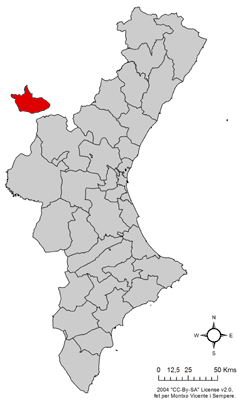Rincón de Ademuz | |
|---|---|
 | |
| Country | |
| Autonomous community | |
| Province | Valencia |
| Capital | Ademuz |
| Municipalities | |
| Area | |
| • Total | 370.22 km2 (142.94 sq mi) |
| Population (2021 Census) | |
| • Total | 2,218 |
| • Density | 6.0/km2 (16/sq mi) |
| [1] | |
| Demonym | |
| Time zone | UTC+1 (CET) |
| • Summer (DST) | UTC+2 (CEST) |
| Largest municipality | Ademuz |
Rincón de Ademuz is a Spanish comarca constituted as an exclave of both the Valencian Community and the Valencia province located between the provinces of Cuenca (Castile-La Mancha) and Teruel (Aragon). It is part of the Spanish-speaking area in the Valencian Community.
Geography[edit]
Overview[edit]
It is a largely rural and sparsely populated area with seven municipalities of which only its capital, Ademuz, has over 1,000 inhabitants.
The area has the river Turia as its major source of water.

Municipalities[edit]
| Name | Population (2001)[2] |
Population (2011)[3] |
Population (2021)[4] |
|---|---|---|---|
| Ademús | 1,115 | 1,250 | 1,033 |
| Casas Altas | 161 | 155 | 130 |
| Casas Bajas | 273 | 227 | 164 |
| Castielfabib | 302 | 301 | 294 |
| La Pobla de Sant Miquel (Puebla de San Miguel) | 66 | 80 | 59 |
| Torre Baixa (Torrebaja) | 423 | 447 | 403 |
| Vallanca | 213 | 161 | 135 |
| Totals | 2,553 | 2,621 | 2,218 |
Bibliography[edit]
- Eslava Blasco, R.: Castielfabib y su patrimonio histórico-artístico. Edición del Ayuntamiento de Castielfabib. 286 Pp. ISBN 978-84-606-4689-1. Castielfabib, 2014.
- Eslava Blasco, R.: Ademuz y su patrimonio histórico-artístico. Ademuz, 2007.
- Eslava Blasco, R.: Vallanca y su patrimonio histórico-artístico religioso. Vallanca, 2006.
- Gargallo Gil, J.E.: Habla y cultura popular en el Rincón de Ademuz. Madrid, 2004.
- Rodrigo Alfonso, C.: El Rincón de Ademuz, análisis comarcal. Valencia, 1998.
- ABABOL. Revista del Instituto Cultural y de Estudios del Rincón de Ademuz (ICERA), dirigida per Ángel Antón Andrés i publicada trimestralment an Ademús des de 1995.
External links[edit]
- Official Web page of El Rincón de Ademuz
- ICERA Instituto de Cultura y Estudios del Rincón de Ademuz and its Journal 'ABABOL'
- Children's stories of El Rincón de Ademuz

Well, that’s interesting to know that Psilotum nudum are known as whisk ferns. Psilotum nudum is the commoner species of the two. While the P. flaccidum is a rare species and is found in the tropical islands. Both the species are usually epiphytic in habit and grow upon tree ferns. These species may also be terrestrial and grow in humus or in the crevices of the rocks.
View the detailed Guide of Psilotum nudum: Detailed Study Of Psilotum Nudum (Whisk Fern), Classification, Anatomy, Reproduction